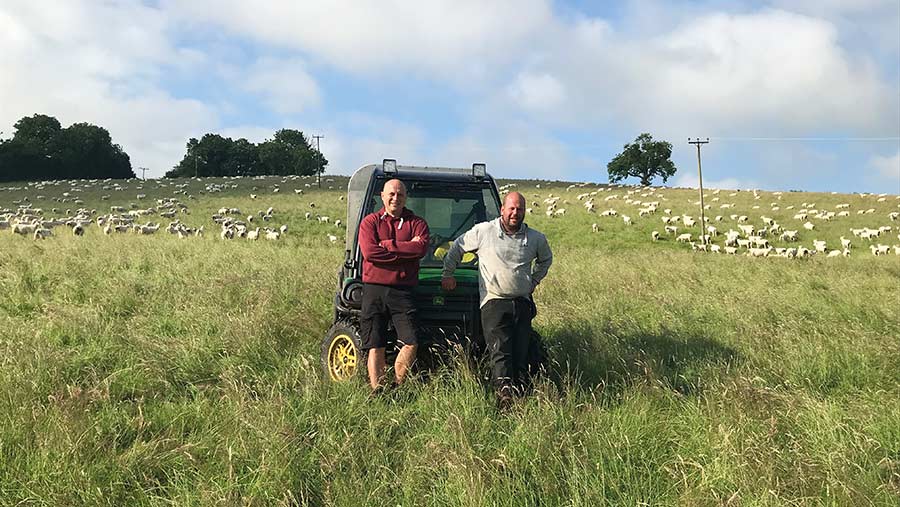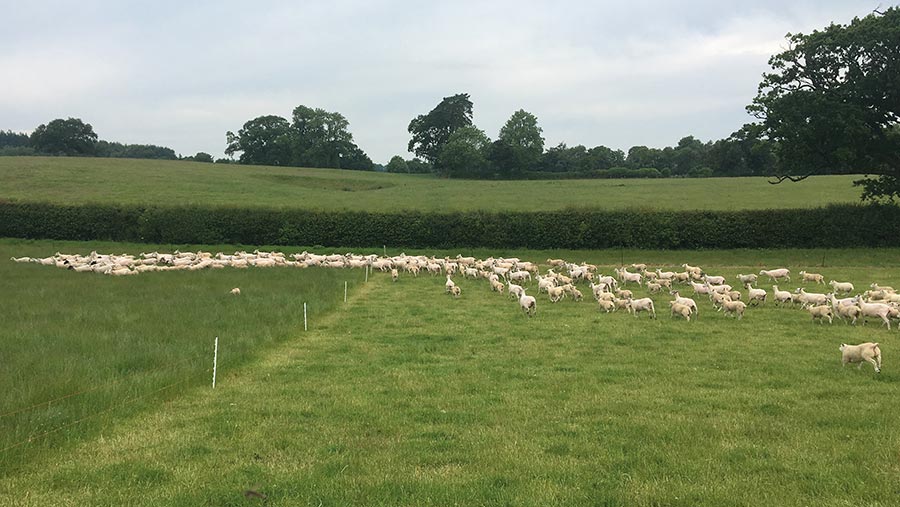How a farm adapted sheep management to overcome dry periods
 Gareth Beynon (left) and Leet Taylor © Gareth Beynon
Gareth Beynon (left) and Leet Taylor © Gareth Beynon Grazing ewes and lambs in mobs of 500 is boosting pasture resilience and soil health on the Rampisham and Cobham Estate in Dorset.
A combination of set stocking and rotational grazing was in place until 2018 when drought exposed shortcomings in that system.
Farm manager Gareth Beynon acted by strip-grazing standing hay and weaning lambs early.
But, amid warnings of drier summers to come, Mr Beynon and estate owner Robert Boileau set about applying longer-term changes to make the system more resilient.
See also: A guide to mob grazing livestock
Farm facts
- 1,651ha (4,078 acres)
- 30 Galloway and 25 Red Devon suckler cows
- Higher Level Countryside Stewardship
- 3,000 Lleyn, Aberfield cross Lleyn and Romney ewes
- Using Aberfield and Abermax sires
- Lambs off forage and turnips
- Finished lambs sold to ABP and Exeter Market
- 250 older ewes are sponged to lamb indoors at the beginning of March to target earlier market
- Main flock lambs from 1 April – triplets indoors and twins and singles outdoors
Changes made
Deep-rooting GS4 herbal leys were planted on 32ha (79 acres) which had been used for growing arable crops.
A legume and herb-rich mix was planted on another 25ha (62 acres) and 61ha (151 acres) of permanent pasture was overseeded with chicory and clover.
Ewe numbers were increased from 1,800 in 2018 to 3,000, to accommodate high-density mob grazing. A longer grass recovery period was also introduced.
Grazing strategy
At lambing, ewes and lambs are set stocked at 10 ewes/ha (4/acre) in 88 paddocks ranging from 2-10ha (5-25 acres).
At first vaccination, and as land is shut up for first cut, the number of groups in the rotation is reduced to about 15.
At second vaccination, which links with shearing, mobs of 500 ewes and their lambs are formed, with each group assigned 10-12 fields each – the aim is for these groups to graze each field for three days and for that field to then rest for 30 days.
This 30-day rotation enables better root structure development.
This grazing system encourages grasses to expand their root systems and builds soil fertility by creating conditions for earthworms and microorganisms to thrive.
“All the plants now have time to reach their full potential. I didn’t think there was much difference between mob and rotational grazing but there is.’’
One of the main principles behind mob grazing is to let the plant grow much taller, with more biomass allowed to encourage root growth below ground.
“From grazing the hay ground in 2018 I realised that sheep do OK when they are grazing tall stuff,” says Mr Beynon.
“Some might argue that this is not good grazing management, but it is soil-friendly and there is always plenty of grass about. We always have grass ahead of the sheep.
“If the grass gets away from us, we can regain control because we have big numbers of sheep. We used to struggle to do that with smaller numbers.”
Benefits
The fields are noticeably greener: even in a dry spell there is grass, says Mr Beynon.
“A lot of the grassland is very old permanent pasture, but that is now improving too, because we are allowing it to reach its full potential.”
Mr Beynon describes the farming system as “low-input, not no input”, but says the changes have helped reduce inputs significantly.
Fertiliser is now only applied to the grassland set aside for first cut haylage, with 220kg/ha used in 2020. Herbal leys receive none.
Soil testing has revealed some exceptional levels of soil organic matter – in one field 17.1% was recorded.
Future
Expanding the flock and employing a shepherd, Lee Taylor, has allowed Mr Beynon to look at the bigger picture for the future of the farming system.
“Regenerative farming is a buzz term at the moment and there is a lot of good in it, but it costs us money to make this farm as nature-friendly as it is.
“If you have got tourists, a farm shop or educational activities on your farm you can make money from those enterprises. With a farming-only system, it is a balancing approach. If the farm is profitable, you can then do things for nature and that must be recognised in the Environmental Land Management (ELM) scheme,” says Mr Beynon.
He believes ELMs should reward farmers for not cultivating fields.
The regenerative system is a long-term project for which he has been given responsibility.
“In 2018, before the drought, I thought I had got the farm to where I wanted it to be, but I was actually just starting the next stage of that journey.”
The numbers
- 155%
Rearing rate in 2021 (target is 160%) - 10%
Percentage of lambs sold at weaning, with the rest sold by December - 18.8kg
The average deadweight of the 2020 lamb crop
Tips for farmers starting out in regenerative farming

© Gareth Beynon
- Get an understanding of grass growth and feed requirements and then simplify it as much as you can to make it work on your own farm
- Don’t get too caught up with measuring kg/DM or paddock sizes – if the fields have enough rest and the mob sizes are large enough, just going from field to field works well, even with small variations in field size
- Select ewes based on body condition score. This is a major factor in good production
- Pull out ewes not “doing” and the rest should look after themselves, with genetics also improving as a result of buying the best rams you can
